wwPDB 2024 News
Contents
12/23/2024
Prizes Awarded at the Asian Crystallographic Association Meeting
The wwPDB Foundation made awards to outstanding student presentations at the 18th Conference of the Asian Crystallographic Association (December 1-6, Kuala Lumpur, Malaysia).
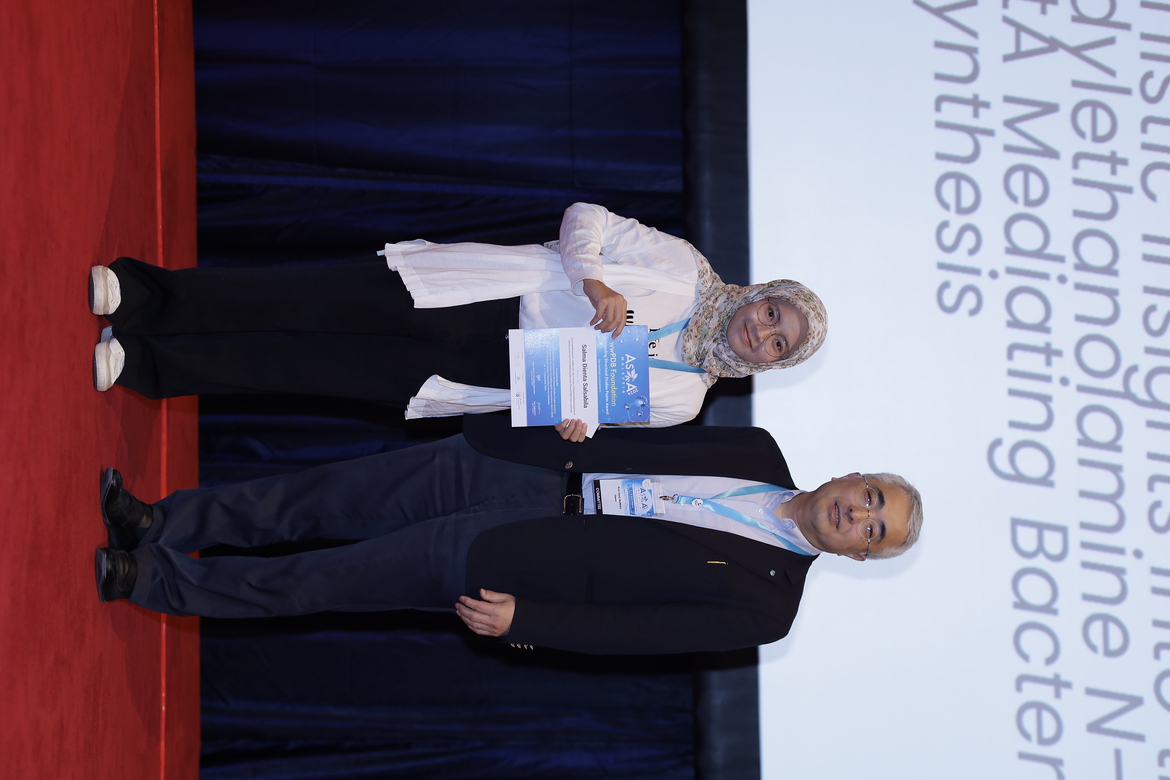 Salma Dienta Salsabila (Gwangju Institute of Science and Technology) and Genji Kurisu (PDBj)
Salma Dienta Salsabila (Gwangju Institute of Science and Technology) and Genji Kurisu (PDBj)Salma Dienta Salsabila (Gwangju Institute of Science and Technology) for Structural Mechanistic Insights into the Function of Phosphatidylethanolamine N-Methyltransferase PmtA Mediating Bacterial Phosphatidylcholine Synthesis
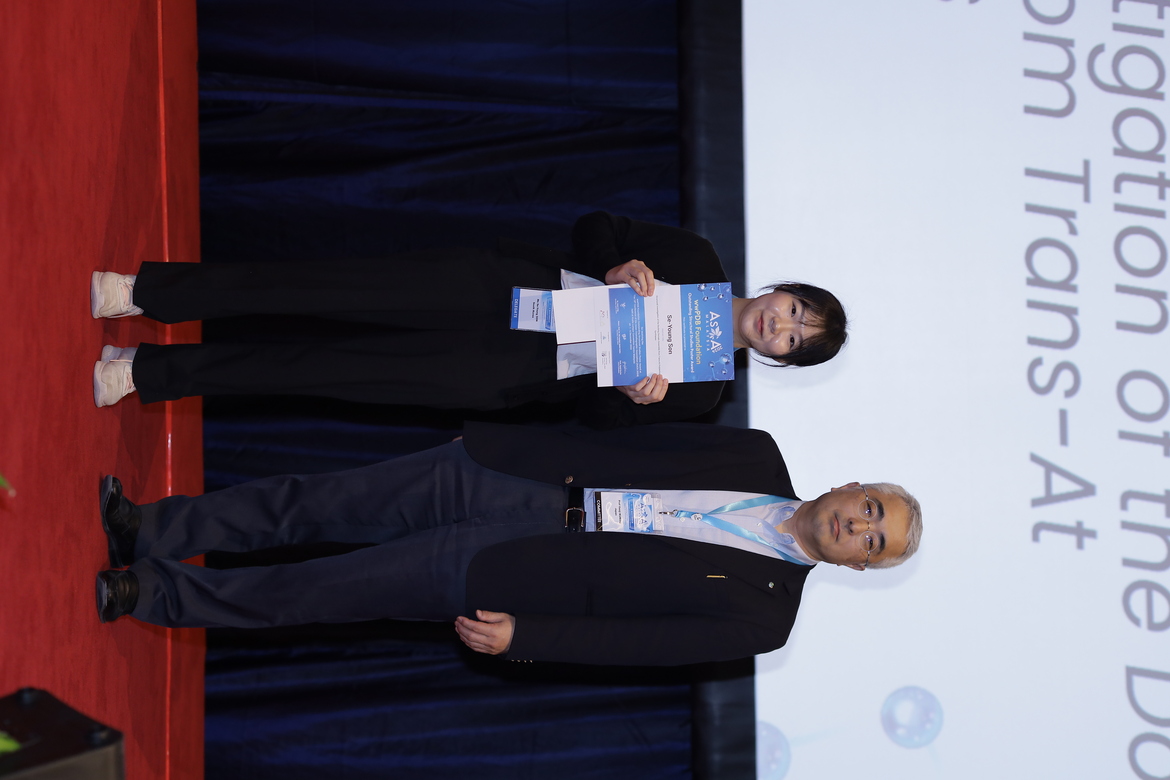 Se-Young Son (Ewha Womans University) and Genji Kurisu (PDBj)
Se-Young Son (Ewha Womans University) and Genji Kurisu (PDBj)Se-Young Son (Ewha Womans University) for Structural Investigation of the Docking Domain Assembly from Trans-At Polyketide Synthases
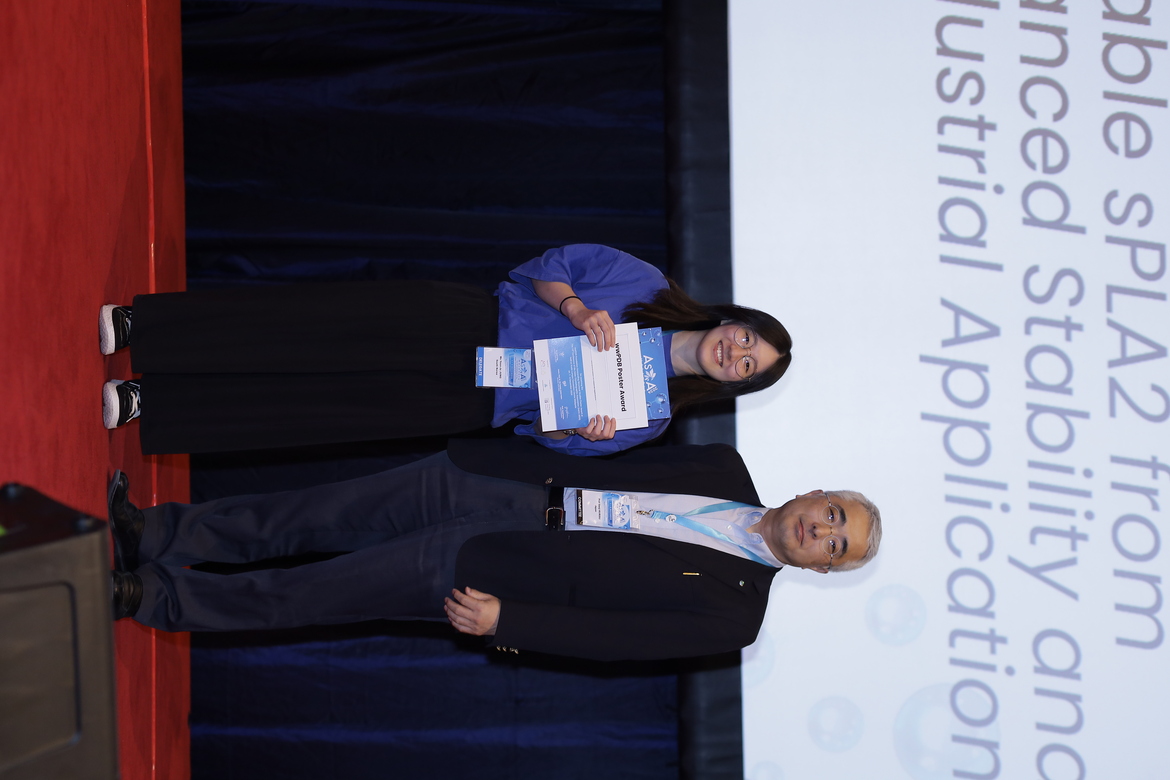 Yeon-Ju Jung (Ewha Womans University) and Genji Kurisu (PDBj)
Yeon-Ju Jung (Ewha Womans University) and Genji Kurisu (PDBj)Yeon-Ju Jung (Ewha Womans University) for Unveiling Thermostable sPLA2 from Sciscionella Marina: Enhanced Stability and Biotransformation for Industrial Applications
Many thanks to the meeting organizers and prize judges for making these awards possible.
The wwPDB Foundation was established in 2010 to raise funds in support of the outreach activities of the wwPDB. The Foundation raised funds to help support PDB50 events, workshops, and educational publications. The Foundation is chartered as a 501(c)(3) entity exclusively for scientific, literary, charitable, and educational purposes.
Consider supporting the next 50 years of PDB's spirit of openness, cooperation, and education with a donation to the wwPDB Foundation.
10/31/2024
Deprecation of FTP File Download Protocol on November 1, 2024
The FTP protocol for file downloads has been losing popularity over the years in favor of HTTP/S. There are many advantages of HTTP/S including speed, statelessness, security (HTTPS), and better support. Importantly during the past 2-3 years the main web browsers (Chrome and Firefox) have dropped support for the FTP protocol, which has effectively discontinued the FTP protocol for non-technical users.
Given that the majority of file download activity on the internet has moved to HTTP/S, wwPDB plans to deprecate FTP download protocol on November 1st 2024 (see previous announcement).
Support for the RSYNC protocol, which offers additional functionality, will continue to be maintained.
As announced previously, wwPDB supports protocol-specific DNS names:
- http://files.wwpdb.org for HTTP/S
- rsync://rsync.wwpdb.org for RSYNC
- ftp.wwpdb.org for FTP; will be deprecated on November 1, 2024. Note this DNS name does not accept HTTP/S traffic.
Please contact info@wwpdb.org with any questions.
10/29/2024
Poster Prize Awarded at The Protein Society
The wwPDB Foundation made an award for outstanding student presentation at the The Protein Society Annual Symposium (Vancouver, Canada; July 23-26, 2024).
 Aubrey Putansu
Aubrey Putansu An Expanded Integrator Sensor Motif for GPCR Ligand Detection
Aubrey Putansu and Wenjing Wang, University of Michigan
Many thanks to the meeting organizers and poster prize judges for making this award possible.
The wwPDB Foundation was established in 2010 to raise funds in support of the outreach activities of the wwPDB. The Foundation raised funds to help support PDB50 events, workshops, and educational publications. The Foundation is chartered as a 501(c)(3) entity exclusively for scientific, literary, charitable, and educational purposes.
The wwPDB Foundation is grateful for our industrial sponsors: Dectris, Discngine, and Rigaku.
Consider supporting the next 50 years of PDB's spirit of openness, cooperation, and education with a donation to the wwPDB Foundation. Industrial and individual sponsorships are available.
10/22/2024
Poster Prize Awarded at LACA
The wwPDB Foundation made an award for outstanding student presentation at the VI Latin American Crystallographic Association Meeting (Montevideo, Uruguay, September 23-26).
 Zaighum Abbas
Zaighum AbbasThe Role of SEPT7 in Magnaporthe oryzae: Structural Insights and Functional Implications
Z Abbas (1), LAV Fernández (1), IA Cavini (2), DA Leonardo (1), RC Garratt (1)
(1)São Carlos Institute of Physics, University of São Paulo
(2)School of Pharmaceutical Sciences of Ribeirão Preto, University of São Paulo
Many thanks to the meeting organizers and poster prize judges for making this award possible.
The wwPDB Foundation was established in 2010 to raise funds in support of the outreach activities of the wwPDB. The Foundation raised funds to help support PDB50 events, workshops, and educational publications. The Foundation is chartered as a 501(c)(3) entity exclusively for scientific, literary, charitable, and educational purposes.
The wwPDB Foundation is grateful for our industrial sponsors: Dectris, Discngine, and Rigaku.
Consider supporting the next 50 years of PDB's spirit of openness, cooperation, and education with a donation to the wwPDB Foundation. Industrial and individual sponsorships are available.
10/16/2024
The Nobel Prize in Chemistry 2024
The Royal Swedish Academy of Sciences has announced that they will award David Baker, Demis Hassabis, and John Jumper the Nobel Prize in Chemistry 2024 for computational protein design and protein structure prediction.
More than 60,000 PDB depositors have submitted experimental data that are carefully reviewed, validated, and biocurated by the wwPDB team. wwPDB partners adhere to the FAIR principles of Findability, Accessibility, Interoperability, and Reusability, and ensure that all archival data can be accessed at no charge and with no limitations on usage under the most permissive Creative Commons CC0 1.0 Universal License.
These PDB data provided training sets for developing protein design and prediction methods recognized by this award. The models generated by AlphaFold and RoseTTAfold produce remarkably accurate 3D structures based on a given sequence. In turn, these models are driving new PDB depositions, as they can be used for molecular replacement in MX or combined with 3DEM density maps to reveal atomic details at a level and quality often unattainable by prediction or experimentation alone.
Also notable is the impact of PDBx/mmCIF, which has become the data standard for structural biology. PDBx/mmCIF provides an extensible data representation that is used for deposition and archiving of experimentally determined 3D structures of biological macromolecules by the wwPDB. Extensions of PDBx/mmCIF (ModelCIF) are similarly used for computed structure models by ModelArchive, for models computed with the AlphaFold 2.0 deep learning software suite, and the AlphaFold Database.
The wwPDB congratulates these researchers and their teams for their revolutionary achievements that have changed the field.
 ©Johan Jarnestad/The Royal Swedish Academy of Sciences
©Johan Jarnestad/The Royal Swedish Academy of SciencesIllustration: A protein can consist of everything from tens of amino acids to several thousand (PDF).
10/15/2024
wwPDB Data Release Policy on Public Preprint Archives
 Preprint publications will trigger wwPDB data archive release
Preprint publications will trigger wwPDB data archive releaseThe wwPDB releases entries under the following circumstances:
- upon author’s request
- upon publication
- at the end of the hold period defined during submission (up to 1 year) if no publication is available by that time
Contributions to public preprint archives that reference PDB, EMDB, or BMRB entry IDs are considered publications by the wwPDB and will therefore trigger release. For example, a PDB structure on hold for publication (status HPUB/HOLD) will be scheduled for release if the wwPDB finds a bioRxiv preprint with matching authors, title, and an entry ID code.
Publication dates and citation details are obtained through a combination of direct communications from authors, journals, and members of the scientific community (communicated via OneDep or deposit-help@mail.wwpdb.org) and PubMed searches (automated comparison of title and author lists included with the deposition and manual review for PDB, EMDB, and BMRB IDs).
Any concerns regarding this policy should be directed to the wwPDB leadership via deposit-help@mail.wwpdb.org.
10/08/2024
Annotation of Protein Modifications in the PDB
The PDB archive is now including annotation of protein chemical modifications (PCMs) and post-translational modifications (PTMs) in a standardized way.
As previously announced, the PDBx/mmCIF dictionary has been extended to enhance PCM and PTM annotation.
This includes new PDBx/mmCIF categories and items as follows:
In the Chemical Component Definition (CCD) files:
- A new item in the chem_comp category: chem_comp.pdbx_pcm, stating whether the CCD is a known PCM/PTM.
- A new category called pdbx_chem_comp_pcm, stating the PCM/PTM type and category, as well as on which positions in the amino acid and in the polypeptide it is expected to be observed. If this PCM is also a known PTM, it will have the Uniprot PTM accession ID.
In the atomic coordinate files:
Additionally to providing this new annotation, any protein modifications that are inconsistently handled within PDB entries are amended, to ensure that a given modification is consistently handled in the PDB archive. This includes a major clean-up of incorrect link records (struct_conn).
All entries containing protein modifications are being re-released gradually from October 2024, throughout Spring 2025.
This standardization ensures that there is a single approach to handling each protein modification that occurs within the PDB archive, allowing better findability.
Questions or feedback? Contact deposit-help@mail.wwpdb.org.
The protein chemical modifications (PCMs) and post translational modifications (PTMs) remediation project is a wwPDB collaborative project carried out principally by PDBe at EMBL-EBI, and is funded by BBSRC grant number BB/V018779/1.
10/02/2024
Access IHM structures at wwPDB DOI Landing Pages
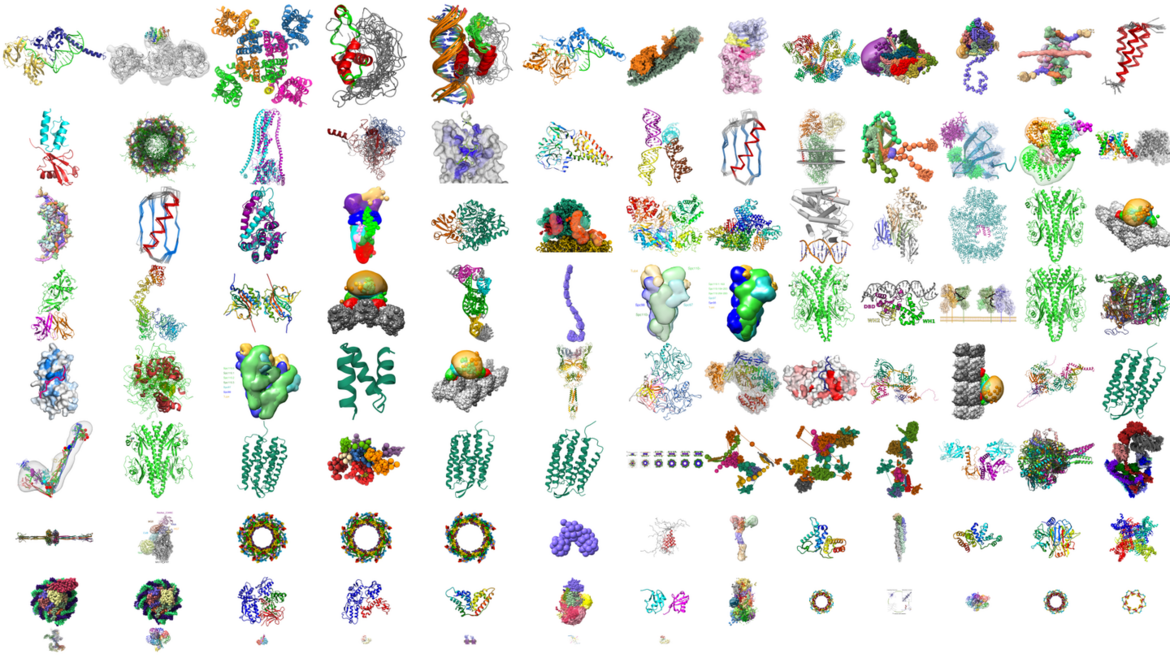 Integrative structures are available at wwPDB.org and the PDB archive
Integrative structures are available at wwPDB.org and the PDB archiveStructures determined by integrative and hybrid structure determination methods (IHM) are now available at wwPDB DOI landing pages for both released and on-hold entries, along with >225,000 experimental structures in the PDB archive. These pages present basic information about the corresponding IHM structure, offer download of model coordinates and validation files from the PDB archive (https://files.wwpdb.org/pub/pdb_ihm/), and provide a link to the PDB-Dev resource that currently serves more detailed information about IHM structures, including the newly available links to PDB DOIs.
For an example, visit the DOI landing page for a recently-released IHM entry in the PDB archive via PDB DOI: https://doi.org/10.2210/pdb9a8n/pdb.
PDB DOIs issued for each IHM or PDB entry are linked from the online versions of papers where PDB IDs are mentioned. Users can distinguish IHM structures from PDB experimental structures on the DOI landing page where IHM structures have “integrative” as structure determination method displayed.
Questions or feedback? Contact deposit-help@mail.wwpdb.org or pdb-dev@mail.wwpdb.org.
09/17/2024
Deprecation of FTP File Download Protocol on November 1, 2024
The FTP protocol for file downloads has been losing popularity over the years in favor of HTTP/S. There are many advantages of HTTP/S including speed, statelessness, security (HTTPS), and better support. Importantly during the past 2-3 years the main web browsers (Chrome and Firefox) have dropped support for the FTP protocol, which has effectively discontinued the FTP protocol for non-technical users.
Given that the majority of file download activity on the internet has moved to HTTP/S, wwPDB plans to deprecate FTP download protocol on November 1st 2024 (see previous announcement).
Support for the RSYNC protocol, which offers additional functionality, will continue to be maintained.
As announced previously, wwPDB supports protocol-specific DNS names:
- http://files.wwpdb.org for HTTP/S
- rsync://rsync.wwpdb.org for RSYNC
- ftp.wwpdb.org for FTP; will be deprecated on November 1, 2024. Note this DNS name does not accept HTTP/S traffic.
Please contact info@wwpdb.org with any questions.
08/28/2024
Biocurator Milestone: >10,000 Depositions Processed
Congratulations to biocurator Dr. Irina Persikova on processing over 10,000 PDB depositions. She is the seventh biocurator in the wwPDB reached this milestone.
Irina has received Ph.D. training in Solid State Physics and provided over 20 years of service to the RCSB PDB. She contributed as an author or co-author to 17 publications and a book chapter.
She has established herself as a highly qualified professional with deep understanding of scientific data and various experimental techniques and dedication to exceptional quality data curation. Her profound data curation expertise and commitment to excellence contributed to the high quality data archive for the benefit of the scientific community. We congratulate Irina with this exciting accomplishment and look forward to her future success.
 Irina Persikova
Irina Persikova
08/14/2024
PDB Archive Serves Structures Determined by Integrative and Hybrid Methods (IHM)
 Integrative structures available in the PDB archive
Integrative structures available in the PDB archiveStructures determined by integrative and hybrid structure determination methods (IHM) are now available alongside experimental structures in the PDB archive. These structures are deposited into and processed by the PDB-Dev system. Each IHM structure is issued a PDB ID, reported in the PDBx/mmCIF file in the _database_2 category, and “integrative” method provenance is captured at _struct.pdbx_structure_determination_methodology. Users can access and download IHM structures and associated data at files.wwpdb.org/pub/pdb_ihm/.
Currently, holding files in JSON format, validation reports (summary and full reports) in PDF format, and model files in PDBx/mmCIF format are provided.
- /pdb_ihm/holdings/ (current holdings, released structures last modified dates, unreleased entries)
- /pdb_ihm/data/entries/hash/{PDB_id}/validation_reports/ (includes summary and full validation reports)
- /pdb_ihm/data/entries/hash/{PDB_id}/structures/ (latest version of model files)
- For example, https://files.wwpdb.org/pub/pdb_ihm/data/entries/zz/8zz1/structures/8zz1.cif.gz
Data may be expanded in the future based on community needs. In the near future, IHM data will also be available via wwPDB DOI landing pages and wwPDB partner websites.
Questions or feedback? Contact deposit-help@mail.wwpdb.org or pdb-dev@mail.wwpdb.org.
06/18/2024
Announcing the New PDBx/mmCIF User Guide
 Benefits of the PDBx/mmCIF ecosystem
Benefits of the PDBx/mmCIF ecosystemWe are excited to announce the launch of a detailed PDBx/mmCIF File Format User Guide.
As the foundation for depositing, annotating, and archiving structural data across diverse experimental techniques, the Protein Data Bank Exchange macromolecular Crystallographic Information Framework (PDBx/mmCIF) stands as the master format of the Protein Data Bank. Our user-friendly guide offers detailed explanation and examples of essential PDBx/mmCIF records, aimed to facilitate a smooth transition to this format for depositors and users alike.
The wwPDB anticipates that all four-character PDB IDs will be exhausted by 2028, after which 12-character PDB IDs will be issued. Entries with extended PDB IDs will not be compatible with the legacy PDB file format and will only be available in PDBx/mmCIF format. wwPDB encourages users to transition to the PDBx/mmCIF format as soon as possible.
 Example PDBx/mmCIF record of a 12-character PDB ID
Example PDBx/mmCIF record of a 12-character PDB IDWe invite all users to participate in a brief survey (accessible from the PDBx/mmCIF File Format User Guide) to share feedback on this guide by December 15, 2024. Your feedback will greatly contribute to future developments.
06/11/2024
Paper Published on NextGen Archive
A new paper describes how the recently-announced NextGen Archive provides centralized access to integrated annotations and enriched structural information for PDB data:
NextGen Archive: Centralising Access to Integrated Annotations and Enriched Structural Information by the Worldwide Protein Data Bank
Preeti Choudhary, Zukang Feng, John Berrisford, Henry Chao, Yasuyo Ikegawa, Ezra Peisach, Dennis W. Piehl, James Smith, Ahsan Tanweer, Mihaly Varadi, John D. Westbrook, Jasmine Y. Young, Ardan Patwardhan, Kyle L. Morris, Jeffrey C. Hoch, Genji Kurisu, Sameer Velankar, Stephen K. Burley
Database (2024) 2024: baae041 https://doi.org/10.1093/database/baae041
The PDB NextGen archive provides sequence annotation from external resources such as UniProt, SCOP2 and Pfam in addition to the content provided in the structure model files in the PDB main archive. The inclusion of UniProtKB numbering facilitates effortless structural comparisons between experimental and predicted protein models. These PDBx/mmCIF files are directly compatible with various data visualization tools, simplifying the display of annotations on 3D structure views.
06/06/2024
Biocurator Milestone: >10,000 Depositions Processed
Congratulations to RCSB PDB's Yuhe Liang on processing over 10,000 PDB depositions. He is the sixth biocurator to reach this milestone in the wwPDB.
Dr. Liang received his PhD in biophysics from Peking University, China with expertise in macromolecular crystallography and joined the PDB after his postdoctoral training on structural and functional studies of important proteins related to human health at University of Pittsburgh School of Medicine.
 Yuhe Liang
Yuhe LiangDuring his 10-year career at RCSB PDB, he has committed his extensive scientific expertise and profound data curation skills to providing excellent data curation services for the Protein Data Bank. His dedication and energy has significantly contributed to high quality data archive for the benefit and advancement of the scientific community. We congratulate Dr. Liang with this exciting accomplishment and look forward to his further career success.
05/08/2024
Poster Prize Awarded at DiscoverBMB
The wwPDB Foundation made an award for outstanding student presentations at the 2024 DiscoverBMB Meeting of the American Society for Biochemistry and Molecular Biology (March 23–26, San Antonio, TX).
 Angela Kayll (James Madison University) and Christine Zardecki (wwPDB Foundation)
Angela Kayll (James Madison University) and Christine Zardecki (wwPDB Foundation)Solution Structure of the hMDH2-hCS Metabolon
Angela Kayll(1), Harrison Tarbox(2), Andrew Pulido(2), Joseph Provost(2), Christopher E. Berndsen(1)
(1)Department of Chemistry and Biochemistry, James Madison University
(2)Department of Chemistry and Biochemistry, University of San Diego
Many thanks to The Biophysical Society organizers and poster prize judges for making this award possible.
The wwPDB Foundation was established in 2010 to raise funds in support of the outreach activities of the wwPDB. The Foundation raised funds to help support PDB50 events, workshops, and educational publications. The Foundation is chartered as a 501(c)(3) entity exclusively for scientific, literary, charitable, and educational purposes.
The wwPDB Foundation is grateful for our industrial sponsors: Discngine, OpenEye Scientific, Roivant Sciences, Rigaku, and ThermoFisher Scientific. Individual sponsorships are also available.
Consider supporting the next 50 years of PDB's spirit of openness, cooperation, and education with a donation to the wwPDB Foundation.
05/07/2024
Celia Schiffer Elected to National Academy of Sciences
 wwPDB Foundation Chair Celia Schiffer
wwPDB Foundation Chair Celia SchifferCelia A. Schiffer, Chair of the wwPDB Foundation and Professor & Chair of Biochemistry & Molecular Biotechnology at the UMass Chan Medical School, has been elected to the National Academy of Sciences (USA).
Schiffer is among 120 members and 24 international members who were elected in recognition of their distinguished and continuing achievements in original research.
The National Academy of Sciences is a private, nonprofit institution that was established under a congressional charter signed by President Abraham Lincoln in 1863. It recognizes achievement in science by election to membership, and—with the National Academy of Engineering and the National Academy of Medicine—provides science, engineering, and health policy advice to the federal government and other organizations.
The Schiffer lab primarily studies the molecular basis for drug resistance in viruses. Through this research, she has developed a new paradigm for avoiding drug resistance in structure-based drug design that translates to other diseases. Her accomplishments in biomedical research have been widely honored. In 2021, she was named the chair of the Department of Biochemistry & Molecular Technology at UMass Chan. She is a fellow of the American Academy of Microbiology and in 2019 was invested as the Gladys Smith Martin Chair in Oncology. In 2020, she was recognized with the William C. Rose Award from the American Society of Biochemistry and Molecular Biology; in 2016 she was named by the Massachusetts Society for Medical Research as educator of the year for excellence in research, mentoring and leadership in bringing women and underrepresented minorities into science; and in 2016 she received the inaugural Chancellor’s Award for Excellence in Mentoring from Chancellor Michael F. Collins.
The wwPDB Foundation was established in 2010 to raise funds in support of the outreach activities of the wwPDB. The Foundation raised funds to help support PDB50 events, workshops, and educational publications. The Foundation is chartered as a 501(c)(3) entity exclusively for scientific, literary, charitable, and educational purposes.
The wwPDB Foundation is grateful for our industrial sponsors: Discngine, OpenEye Scientific, Roivant Sciences, Rigaku, and ThermoFisher Scientific. Individual sponsorships are also available. Consider supporting the next 50 years of PDB's spirit of openness, cooperation, and education with a donation to the wwPDB Foundation.
04/30/2024
Coming soon: Annotation of Protein Modifications in the PDB
The standardization of protein modification handling ensures that there is a single correct approach to handling each protein modification that occurs within the PDB archive. However, there are many existing PDB entries that contain protein modifications which do not follow these handling conventions.
As part of the protein modifications remediation project, all model coordinates files containing protein modifications are being re-released to add a new protein modification data category. This new category will list all observed PCMs/PTMs within the entry, as well as their type and category, allowing better findability.
A new category will also be added to the Chemical Component Definition (CCD) files. It will state whether the CCD is a known PCM, its type and category, as well as on which positions in the amino acid and in the polypeptide it is expected to be observed. If this PCM is also a known PTM, it will have the Uniprot generic PTM accession ID.
Finally, any protein modifications that are inconsistently handled within a PDB entry will be amended, to ensure that a given modification is consistently handled in the PDB archive.
Detailed information about this work is available from GitHub, including PDBx/mmCIF dictionary extension and a set of example files, and complete documentation of the additional annotation.
Questions or feedback? Contact deposit-help@mail.wwpdb.org.
The protein chemical modifications (PCMs) and post translational modifications (PTMs) remediation project is a wwPDB collaborative project carried out principally by PDBe at EMBL-EBI, and is funded by BBSRC grant number BB/V018779/1.
04/08/2024
CASP16 Call for Targets
 CASP (Critical Assessment of protein Structure Prediction) is in search for targets.
CASP (Critical Assessment of protein Structure Prediction) is in search for targets.CASP (Critical Assessment of protein Structure Prediction) experiments are held every two years. Recent rounds have seen dramatic increases in modeling accuracy, resulting from the introduction of deep learning methods: In 2018, for the first time, the folds of most proteins were correctly computed [1]; in 2020, the accuracy of many computed protein structures rivaled that of the corresponding experimental ones [2]; in 2022, there was an enormous increase in the accuracy of protein complexes [3].
We have seen the beginning of what deep learning methods may achieve in structural biology. In addition to further increases in the accuracy of protein complexes, methods are being developed for RNA structures, organic ligand-protein complexes, and for moving beyond single macromolecular structures to compute conformational ensembles. Accurate computational methods together with experimental data also offer the prospect of probing previously inaccessible biological systems. CASP has expanded its scope to provide critical assessment in all these areas.
CASP is only possible with the generous participation of the experimental structural biology community in providing suitable targets: A total of over 1100 targets have been obtained over the previous CASP rounds. We are now requesting targets for the 2024 CASP16 experiment. We need challenge targets in the following areas:
Single protein structures: The 2020 and 2022 CASPs showed that, so far, Alphafold2 and methods built around it are by far the most accurate [4]. But there are limitations, particularly for some proteins where only a shallow sequence alignment is available and for very large proteins (more than 1000 amino acids). The best results also require substantial amounts of computing resources, well beyond that of the AlphaFold2 default settings. Many new methods are continuing to appear and these may remove some of the remaining difficulties. All types of protein targets are needed, but especially those with shallow sequence alignments, without structural templates, and large proteins.
Protein complexes: In the 2022 CASP15, advanced deep learning methods were applied to protein complexes for the first time [5]. The result was a huge improvement in accuracy compared with classical docking approaches. But overall, the results are still not at the level achieved for single proteins. So, in CASP16 we need all sorts of targets in this area so as to determine progress since then. We particularly need complexes where there is no evolutionary information across the protein-protein interfaces, for example, antibody-antigen complexes. (This CASP category is conducted in close collaboration with our colleagues at CAPRI - Critical Assessment of protein interactions [6]).
Nucleic acid structures and complexes: In recognition of the major role nucleic acid structures and complexes play in biology, CASP now includes this class of target. A number of papers claiming successful RNA structure computation using deep learning methods have been published, but those participating in the 2022 CASP RNA category performed less well than classical approaches, and no methods were able to effectively address the two RNA protein-complexes included [7]. CASP needs a wide variety of RNA, DNA, and complexes as targets to see if this situation has changed. (This CASP category is conducted in close collaboration with RNApuzzles [8]).
Organic ligand-protein complexes: This area is of major importance for computer-aided drug discovery. Earlier, there have been community experiments to assess the accuracy of methods, particularly SAMPL, CSAR, D3R, and a new one, CACHE, has recently started. These challenges have drawn strong international participation from researchers in both academia and industry. Here too, a number of promising deep learning papers have appeared, but in the 2022 CASP15 pilot, classical methods were still superior [9]. So, we need appropriate targets to see if progress has been made since. Ideally, these should be sets of three-dimensional protein-ligand complexes from drug discovery projects, but single targets would also be appreciated. Additionally, where available, we will assess non-structural quantities such as affinities or affinity rankings and other properties of pharmaceutical interest when these are available (small molecule pKs, and DMPK related properties).
Ensembles of macromolecule conformations: It is now widely recognized that proteins and nucleic acids often adopt multiple conformations that can underpin their functions. In these cases, considering only a single protein or RNA conformation may be a significant oversimplification. The 2022 CASP15 included a pilot experiment to assess methods for computing multiple conformations, with encouraging results [10], but with limitations imposed by the available experimental data. For 2024, we seek not only cases of multiple experimental three-dimensional structures for the same macromolecule but also other types of data that might be used for assessment of computed conformation ensembles such as cryoEM, NMR, X-ray crystallography, SAXS, and/or cross-link data.
Integrative modeling: The more powerful computational methods open up new possibilities for combination with sparse or low-resolution experimental data to investigate previously inaccessible biological structures and machines. CASP is interested in exploring these possibilities and so requests experimentally difficult targets where structure has nevertheless been obtained. In appropriate cases, we expect to be able to collaborate with other experimental groups to provide appropriate data from NMR, cross-linking or SAXS.
There are three avenues to contribute a target to CASP:
- (preferred) Submit directly to CASP through our web-interface (requires a quick registration if you do not have an account with us).
- Email to targets@predictioncenter.org with your target suggestions or to discuss any questions.
- Submit your structure to the PDB (on-hold) and designate it as a CASP target through PDB’s submission interface.
The timeline for the 2024 CASP requires that targets are submitted starting now and until July 1. We would like to hear from you as soon as possible if you may have something suitable or have suggestions about other target sources. In order to maintain rigor, the experimental data for a target must not be publicly available until after computed structures have been collected. For assessment, CASP requires the experimental data by August 15, but the data can remain confidential after that. Target providers are invited to contribute to papers [11-15] for a special CASP issue of the journal Proteins.
CASP organizers: John Moult, Krzysztof Fidelis, Andriy Kryshtafovych, Torsten Schwede, Maya Topf
- Kryshtafovych A, Schwede T, Topf M, Fidelis K, Moult J. Critical assessment of methods of protein structure prediction (CASP)-Round XIII. Proteins 2019;87(12):1011-1020.
- Kryshtafovych A, Schwede T, Topf M, Fidelis K, Moult J. Critical assessment of methods of protein structure prediction (CASP)-Round XIV. Proteins 2021;89(12):1607-1617.
- Kryshtafovych A, Schwede T, Topf M, Fidelis K, Moult J. Critical assessment of methods of protein structure prediction (CASP)-Round XV. Proteins 2023;91(12):1539-1549.
- Simpkin AJ, Mesdaghi S, Sanchez Rodriguez F, Elliott L, Murphy DL, Kryshtafovych A, Keegan RM, Rigden DJ. Tertiary structure assessment at CASP15. Proteins 2023;91(12):1616-1635.
- Ozden B, Kryshtafovych A, Karaca E. The impact of AI-based modeling on the accuracy of protein assembly prediction: Insights from CASP15. Proteins 2023;91(12):1636-1657.
- Lensink MF, Brysbaert G, Raouraoua N, Bates PA, Giulini M, Honorato RV, van Noort C, Teixeira JMC, Bonvin A, Kong R, Shi H, Lu X, Chang S, Liu J, Guo Z, Chen X, Morehead A, Roy RS, Wu T, Giri N, Quadir F, Chen C, Cheng J, Del Carpio CA, Ichiishi E, Rodriguez-Lumbreras LA, Fernandez-Recio J, Harmalkar A, Chu LS, Canner S, Smanta R, Gray JJ, Li H, Lin P, He J, Tao H, Huang SY, Roel-Touris J, Jimenez-Garcia B, Christoffer CW, Jain AJ, Kagaya Y, Kannan H, Nakamura T, Terashi G, Verburgt JC, Zhang Y, Zhang Z, Fujuta H, Sekijima M, Kihara D, Khan O, Kotelnikov S, Ghani U, Padhorny D, Beglov D, Vajda S, Kozakov D, Negi SS, Ricciardelli T, Barradas-Bautista D, Cao Z, Chawla M, Cavallo L, Oliva R, Yin R, Cheung M, Guest JD, Lee J, Pierce BG, Shor B, Cohen T, Halfon M, Schneidman-Duhovny D, Zhu S, Yin R, Sun Y, Shen Y, Maszota-Zieleniak M, Bojarski KK, Lubecka EA, Marcisz M, Danielsson A, Dziadek L, Gaardlos M, Gieldon A, Liwo A, Samsonov SA, Slusarz R, Zieba K, Sieradzan AK, Czaplewski C, Kobayashi S, Miyakawa Y, Kiyota Y, Takeda-Shitaka M, Olechnovic K, Valancauskas L, Dapkunas J, Venclovas C, Wallner B, Yang L, Hou C, He X, Guo S, Jiang S, Ma X, Duan R, Qui L, Xu X, Zou X, Velankar S, Wodak SJ. Impact of AlphaFold on structure prediction of protein complexes: The CASP15-CAPRI experiment. Proteins 2023;91(12):1658-1683.
- Das R, Kretsch RC, Simpkin AJ, Mulvaney T, Pham P, Rangan R, Bu F, Keegan RM, Topf M, Rigden DJ, Miao Z, Westhof E. Assessment of three-dimensional RNA structure prediction in CASP15. Proteins 2023;91(12):1747-1770.
- Magnus M, Antczak M, Zok T, Wiedemann J, Lukasiak P, Cao Y, Bujnicki JM, Westhof E, Szachniuk M, Miao Z. RNA-Puzzles toolkit: a computational resource of RNA 3D structure benchmark datasets, structure manipulation, and evaluation tools. Nucleic Acids Res 2020;48(2):576-588.
- Robin X, Studer G, Durairaj J, Eberhardt J, Schwede T, Walters WP. Assessment of protein-ligand complexes in CASP15. Proteins 2023;91(12):1811-1821.
- Kryshtafovych A, Montelione GT, Rigden DJ, Mesdaghi S, Karaca E, Moult J. Breaking the conformational ensemble barrier: Ensemble structure modeling challenges in CASP15. Proteins 2023;91(12):1903-1911.
- Kretsch RC, Andersen ES, Bujnicki JM, Chiu W, Das R, Luo B, Masquida B, McRae EKS, Schroeder GM, Su Z, Wedekind JE, Xu L, Zhang K, Zheludev IN, Moult J, Kryshtafovych A. RNA target highlights in CASP15: Evaluation of predicted models by structure providers. Proteins 2023;91(12):1600-1615.
- Alexander LT, Durairaj J, Kryshtafovych A, Abriata LA, Bayo Y, Bhabha G, Breyton C, Caulton SG, Chen J, Degroux S, Ekiert DC, Erlandsen BS, Freddolino PL, Gilzer D, Greening C, Grimes JM, Grinter R, Gurusaran M, Hartmann MD, Hitchman CJ, Keown JR, Kropp A, Kursula P, Lovering AL, Lemaitre B, Lia A, Liu S, Logotheti M, Lu S, Markusson S, Miller MD, Minasov G, Niemann HH, Opazo F, Phillips GN, Jr., Davies OR, Rommelaere S, Rosas-Lemus M, Roversi P, Satchell K, Smith N, Wilson MA, Wu KL, Xia X, Xiao H, Zhang W, Zhou ZH, Fidelis K, Topf M, Moult J, Schwede T. Protein target highlights in CASP15: Analysis of models by structure providers. Proteins 2023;91(12):1571-1599.
- Alexander LT, Lepore R, Kryshtafovych A, Adamopoulos A, Alahuhta M, Arvin AM, Bomble YJ, Bottcher B, Breyton C, Chiarini V, Chinnam NB, Chiu W, Fidelis K, Grinter R, Gupta GD, Hartmann MD, Hayes CS, Heidebrecht T, Ilari A, Joachimiak A, Kim Y, Linares R, Lovering AL, Lunin VV, Lupas AN, Makbul C, Michalska K, Moult J, Mukherjee PK, Nutt WS, Oliver SL, Perrakis A, Stols L, Tainer JA, Topf M, Tsutakawa SE, Valdivia-Delgado M, Schwede T. Target highlights in CASP14: Analysis of models by structure providers. Proteins 2021;89(12):1647-1672.
- Lepore R, Kryshtafovych A, Alahuhta M, Veraszto HA, Bomble YJ, Bufton JC, Bullock AN, Caba C, Cao H, Davies OR, Desfosses A, Dunne M, Fidelis K, Goulding CW, Gurusaran M, Gutsche I, Harding CJ, Hartmann MD, Hayes CS, Joachimiak A, Leiman PG, Loppnau P, Lovering AL, Lunin VV, Michalska K, Mir-Sanchis I, Mitra AK, Moult J, Phillips GN, Jr., Pinkas DM, Rice PA, Tong Y, Topf M, Walton JD, Schwede T. Target highlights in CASP13: Experimental target structures through the eyes of their authors. Proteins 2019;87(12):1037-1057.
- Kryshtafovych A, Albrecht R, Basle A, Bule P, Caputo AT, Carvalho AL, Chao KL, Diskin R, Fidelis K, Fontes C, Fredslund F, Gilbert HJ, Goulding CW, Hartmann MD, Hayes CS, Herzberg O, Hill JC, Joachimiak A, Kohring GW, Koning RI, Lo Leggio L, Mangiagalli M, Michalska K, Moult J, Najmudin S, Nardini M, Nardone V, Ndeh D, Nguyen TH, Pintacuda G, Postel S, van Raaij MJ, Roversi P, Shimon A, Singh AK, Sundberg EJ, Tars K, Zitzmann N, Schwede T. Target highlights from the first post-PSI CASP experiment (CASP12, May-August 2016). Proteins 2018;86 Suppl 1(Suppl 1):27-50.
03/21/2024
Paper Published on NMR Restraint Validation
We are pleased to announce the publication of this manuscript, addressing the challenge of validation of experimental biomolecular NMR structures against restraint data.
The NMR exchange (NEF) and NMR-STAR formats provide a standardized approach for representing commonly used NMR restraints. Using these restraint formats, a standardized validation system for assessing structural models of biopolymers against restraints has been developed and implemented in the wwPDB OneDep data harvesting system.
The resulting wwPDB Restraint Violation Report provides a model vs data assessment of biomolecule structures determined using distance and dihedral restraints, with extensions to other restraint types currently being implemented. These tools are useful for assessing NMR models, as well as for assessing biomolecular structure predictions based on distance restraints.
We present the rationale for model-vs-data restraint validation by the wwPDB, together with summary of validation tools and reports for NMR distance and dihedral restraints that have been developed, as implemented in the wwPDB validation pipeline and recommended by the wwPDB NMR-VTF committee.
Restraint Validation of Biomolecular Structures Determined by NMR in the Protein Data Bank
Kumaran Baskaran, Eliza Ploskon, Roberto Tejero, Masashi Yokochi, Deborah Harrus, Yuhe Liang, Ezra Peisach, Irina Persikova, Theresa A Ramelot, Monica Sekharan, James Tolchard, John D Westbrook, Benjamin Bardiaux, Charles Schwieters, Ardan Patwardhan, Sameer Velankar, Stephen K Burley, Genji Kurisu, Jeffrey C Hoch, Gaetano T Montelione, Geerten W Vuister, Jasmine Y Young
(2024) Structure 32, 1–14: doi: 10.1016/j.str.2024.02.011
The wwPDB plans to further enhance validation report by providing model-vs-data quality assessment for other kinds of restraints based on community recommendation and improve data representation on structures with multiple conformation states.
03/12/2024
Paper Published on CryoEM Archiving and Validation Recommendations
A workshop was held at EMBL-EBI (Hinxton, UK) in January 2020 to discuss data requirements for deposition and validation of cryoEM structures, with a focus on single-particle analysis and setting community recommendations. The outcomes of this meeting have now been published in this manuscript which highlights the recent achievements made by the wwPDB in the space of 3DEM validation and the community recommendations going forward. Some of these recommendations have already been implemented, such as a three-tiered strategy powered by the Validation Analysis (VA) pipeline for the dissemination of validation information and ensuring the that VA can be run by external applications.
Community recommendations on cryoEM data archiving and validation
Gerard J. Kleywegt, Paul D. Adams, Sarah J. Butcher, Cathy Lawson, Alexis Rohou, Peter B. Rosenthal, Sriram Subramaniam, Maya Topf, Sanja Abbott, Philip R. Baldwin, John M. Berrisford, Gérard Bricogne, Preeti Choudhary, Tristan I. Croll, Radostin Danev, Sai J. Ganesan, Timothy Grant, Aleksandras Gutmanas, Richard Henderson, J. Bernard Heymann, Juha T. Huiskonen, Andrei Istrate, Takayuki Kato, Gabriel C. Lander, Shee-Mei Lok, Steven J. Ludtke, Garib N. Murshudov, Ryan Pye, Grigore D. Pintilie, Jane S. Richardson, Carsten Sachse, Osman Salih, Sjors H.W. Scheres, Gunnar F. Schroeder, Carlos Oscar S. Sorzano, Scott M. Stagg, Zhe Wang, Rangana Warshamanage, John D. Westbrook, Martyn D. Winn, Jasmine Y. Young, Stephen K. Burley, Jeffrey C. Hoch, Genji Kurisu, Kyle Morris, Ardan Patwardhan, Sameer Velankar
(2024) IUCrJ 11: 140–151 https://doi.org/10.1107/S2052252524001246
 Graphical Abstract
Graphical Abstract
03/06/2024
Poster Prize Awarded at The Biophysical Society Meeting
The wwPDB Foundation made an award for outstanding student presentations at the 2024 Biophysical Society Meeting (February 10-14, Philadelphia, PA).
 Irin Pottanani Tom
Irin Pottanani TomMechanisms of Light Signalling and Allosteric Regulation in Dual Sensor Photoreceptor PPHK
Irin Pottanani Tom (1), Heewhan Shin (1), Chang Liu (2), Indika Kumaeapperuma (1), Zhong Ren (1), Minglei Zhao (1), Xiaojing Yang (1)
1) University of Illinois at Chicago, 2) University of Chicago
Many thanks to The Biophysical Society organizers and poster prize judges for making this award possible.
The wwPDB Foundation was established in 2010 to raise funds in support of the outreach activities of the wwPDB. The Foundation raised funds to help support PDB50 events, workshops, and educational publications. The Foundation is chartered as a 501(c)(3) entity exclusively for scientific, literary, charitable, and educational purposes.
The wwPDB Foundation is grateful for our industrial sponsors: Discngine, OpenEye Scientific, Roivant Sciences, Rigaku, and ThermoFisher Scientific. Individual sponsorships are also available.
Consider supporting the next 50 years of PDB's spirit of openness, cooperation, and education with a donation to the wwPDB Foundation.
02/27/2024
Latest Developments on the EMDB Published
This manuscript addresses the recent developments in the archiving of 3DEM data and the future plans for the EMDB. The burgeoning popularity of the electron microscopy field has been coupled with new technologies and software solutions, together this has pushed exponential growth in yearly depositions, increases in the resolution of the deposited data, and, consequently, accuracy of molecule models associated with 3DEM data. As the EMDB continues to grow it remains dedicated to delivering a world-class archive that adheres to FAIR principles. In addition, we recognise the importance of easy and open access to accurately curated data for the various users of the archive, we plan to continue to facilitate and enhance this moving forward.
EMDB—the Electron Microscopy Data Bank
The wwPDB Consortium
Nucleic Acids Research (2024) 52: D456–D465 https://doi.org/10.1093/nar/gkad1019
02/11/2024
Biocurator Milestone: >10,000 Depositions Processed
Congratulations to biocurator Minyu Chen on processing over 10,000 PDB depositions. She is the second biocurator to reach this milestone in the PDBj and the fifth in the wwPDB. Yumiko Kengaku reached this milestone in April 2021.
Minyu received her PhD in Environmental Engineering from Osaka University and joined PDB after working at the National Cerebral and Cardiovascular Center, Osaka. She has joined PDB in 2007 and is now working at the branch office of PDBj in the Protein Research Foundation, Osaka. She has established herself as a highly qualified professional with deep understanding of scientific data and various experimental techniques and dedication to exceptional quality data curation. Her profound data curation expertise and commitment to excellence contributed to the high quality data archive for the benefit of the scientific community. We congratulate Minyu with this exciting accomplishment and look forward to her future success.
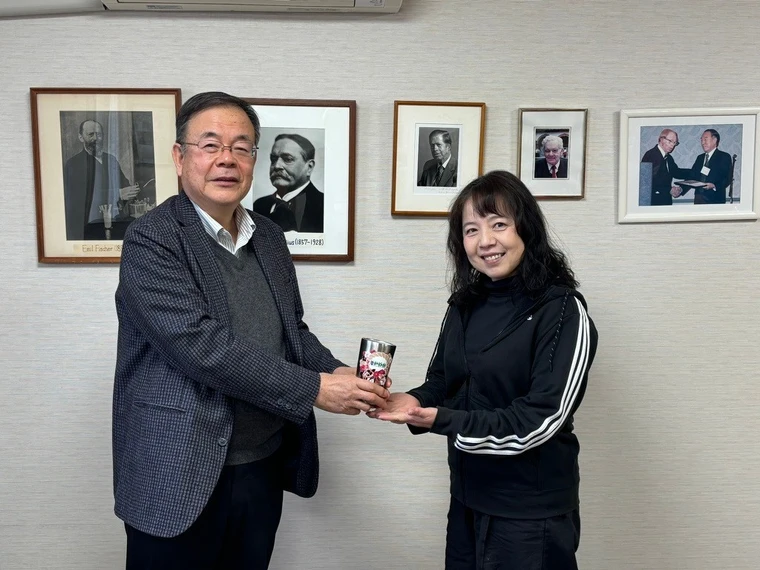 Chairman of the Protein Research Foundation, Prof. Toshiharu Hase, and Dr. Minyu Chen.
Chairman of the Protein Research Foundation, Prof. Toshiharu Hase, and Dr. Minyu Chen.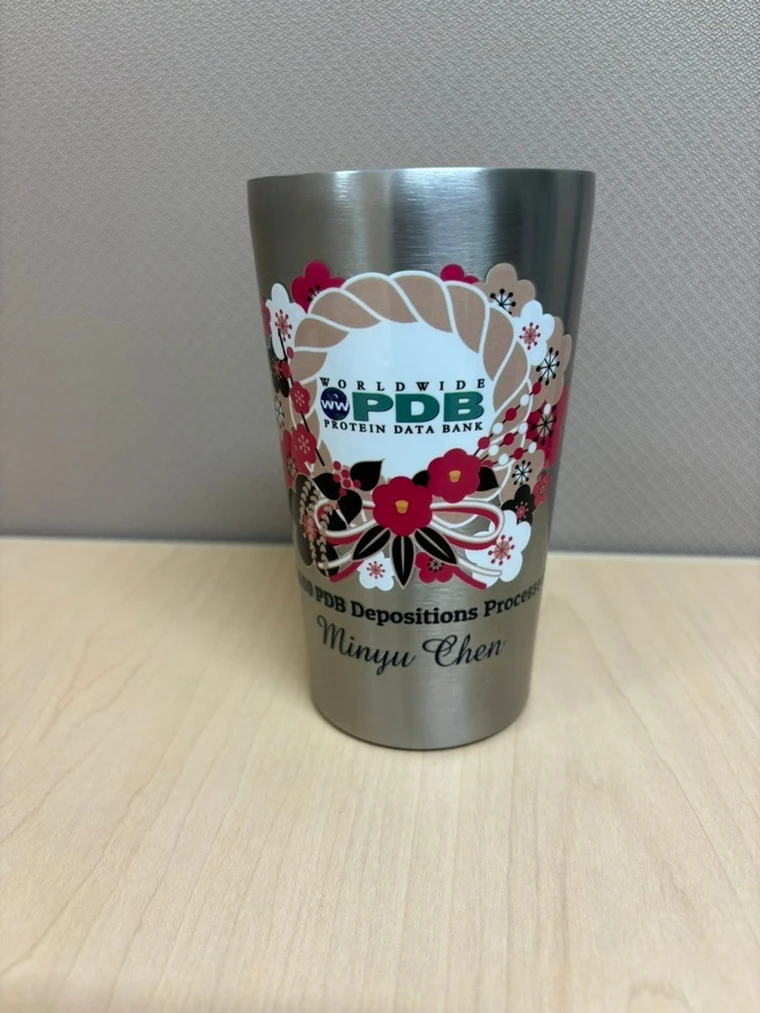 Milestone tumbler.
Milestone tumbler.
02/05/2024
Preprint Published on NMR Restraint Validation
 Graphical Abstract
Graphical AbstractThis manuscript addresses this challenge of validation of experimental biomolecular NMR structures against restraint data. The NMR exchange (NEF) and NMR-STAR formats provide a standardized approach for representing commonly used NMR restraints. Using these restraint formats, a standardized validation system for assessing structural models of biopolymers against restraints has been developed and implemented in the wwPDB OneDep data harvesting system. The resulting wwPDB Restraint Violation Report provides a model vs data assessment of biomolecule structures determined using distance and dihedral restraints, with extensions to other restraint types currently being implemented. These tools are useful for assessing NMR models, as well as for assessing biomolecular structure predictions based on distance restraints. We presented the rationale for model-vs-data restraint validation by the wwPDB, together with summary of validation tools and reports for NMR distance and dihedral restraints that have been developed, as implemented in the wwPDB validation pipeline and recommended by the wwPDB NMR-VTF committee.
Restraint Validation of Biomolecular Structures Determined by NMR in the Protein Data Bank
Kumaran Baskaran, Eliza Ploskon, Roberto Tejero, Masashi Yokochi, Deborah Harrus, Yuhe Liang, Ezra Peisach, Irina Persikova, Theresa A Ramelot, Monica Sekharan, James Tolchard, John D Westbrook, Benjamin Bardiaux, Charles Schwieters, Ardan Patwardhan, Sameer Velankar, Stephen K Burley, Genji Kurisu, Jeffrey C Hoch, Gaetano T Montelione, Geerten W Vuister, Jasmine Y Young
(2024) bioRxiv 2024.01.15.575520; doi: 10.1101/2024.01.15.575520
wwPDB plans to further enhance validation report by providing model-vs-data quality assessment for other kinds of restraints based on community recommendation and improve data representation on structures with multiple conformation states.
02/01/2024
Preprint Published on CryoEM Archiving and Validation Recommendations
 The number of released EMDB entries per year in a number of resolution bins, from
2010 until December 2023
The number of released EMDB entries per year in a number of resolution bins, from
2010 until December 2023A workshop was held at EMBL-EBI (Hinxton, UK) in January 2020 to discuss data requirements for deposition and validation of cryoEM structures, with a focus on single-particle analysis and set community recommendations.
Community recommendations on cryoEM data archiving and validation
Gerard J. Kleywegt, Paul D. Adams, Sarah J. Butcher, Cathy Lawson, Alexis Rohou, Peter B. Rosenthal, Sriram Subramaniam, Maya Topf, Sanja Abbott, Philip R. Baldwin, John M. Berrisford, Gérard Bricogne, Preeti Choudhary, Tristan I. Croll, Radostin Danev, Sai J. Ganesan, Timothy Grant, Aleksandras Gutmanas, Richard Henderson, J. Bernard Heymann, Juha T. Huiskonen, Andrei Istrate, Takayuki Kato, Gabriel C. Lander, Shee-Mei Lok, Steven J. Ludtke, Garib N. Murshudov, Ryan Pye, Grigore D. Pintilie, Jane S. Richardson, Carsten Sachse, Osman Salih, Sjors H.W. Scheres, Gunnar F. Schroeder, Carlos Oscar S. Sorzano, Scott M. Stagg, Zhe Wang, Rangana Warshamanage, John D. Westbrook, Martyn D. Winn, Jasmine Y. Young, Stephen K. Burley, Jeffrey C. Hoch, Genji Kurisu, Kyle Morris, Ardan Patwardhan, Sameer Velankar
(2023) arXiv doi: 10.48550/arXiv.2311.17640
Several community recommendations from this workshop have been incorporated into wwPDB validation reports including map analysis, FSC validation, and map-model fitness using Q-score. wwPDB plans to provide overall quality percentile on map-model fitness compared to other PDB entries in the wwPDB validation report as the next step.
01/29/2024
Preprint Published on NextGen Archive
A new paper describes how the recently-announced NextGen Archive provides centralized access to integrated annotations and enriched structural information for PDB data:
NextGen Archive: Centralising Access to Integrated Annotations and Enriched Structural Information by the Worldwide Protein Data Bank
Preeti Choudhary, Zukang Feng, John Berrisford, Henry Chao, Yasuyo Ikegawa, Ezra Peisach, Dennis W. Piehl, James Smith, Ahsan Tanweer, Mihaly Varadi, John D. Westbrook, Jasmine Y. Young, Ardan Patwardhan, Kyle L. Morris, Jeffrey C. Hoch, Genji Kurisu, Sameer Velankar, Stephen K. Burley
(2023) bioRxiv doi: 10.1101/2023.10.24.563739
The PDB NextGen archive provides sequence annotation from external resources such as UniProt, SCOP2 and Pfam in addition to the content provided in the structure model files in the PDB main archive. The inclusion of UniProtKB numbering facilitates effortless structural comparisons between experimental and predicted protein models. These PDBx/mmCIF files are directly compatible with various data visualization tools, simplifying the display of annotations on 3D structure views.
01/28/2024
Prizes Awarded at The Biophysical Society Japan Meeting
The wwPDB Foundation made awards to outstanding student presentations at the 2023 The Biophysical Society Japan Meeting (November 14-16, Nagoya, Japan).
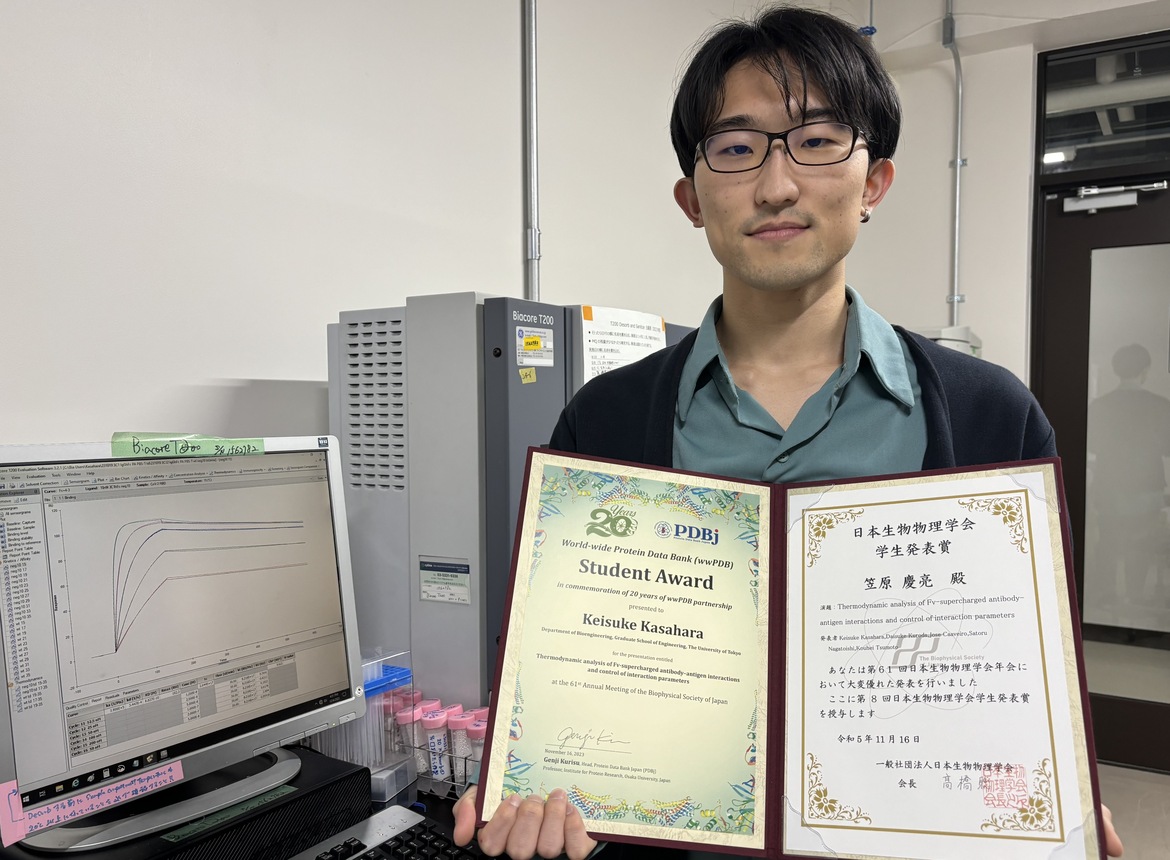 Keisuke Kasahara
Keisuke KasaharaThermodynamic analysis of Fv-supercharged antibody–antigen interactions and control of interaction parameters
Keisuke Kasahara (1), Daisuke Kuroda (2), Jose Caaveiro (3), Satoru Nagatoishi (4), Kouhei Tsumoto (1,4)
1) Dept. Bioeng., Grad. Sch. Eng., Univ. Tokyo; 2) Res. Ctr. Drug Vaccine Dev., NIID; 3) Grad. Sch. Pharm. Sci., Kyusyu Univ., 4) Med. Dev. Dev. Reg. Res. Ctr., Grad. Sch. Eng., Univ. Tokyo
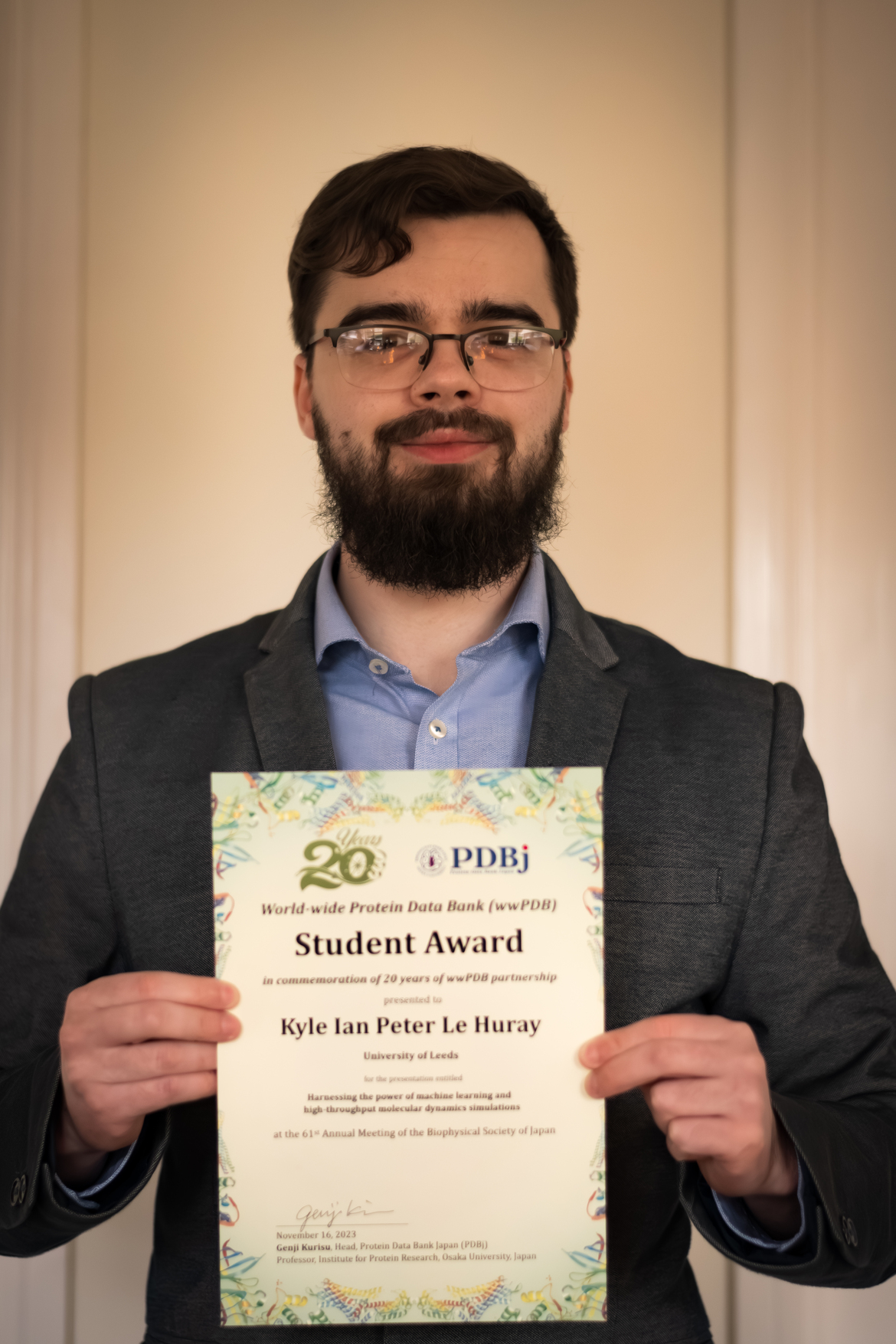 Kyle Ian Peter Le Huray
Kyle Ian Peter Le HurayHarnessing the power of machine learning and high-throughput molecular dynamics simulations to predict protein-lipid interactions Kyle Ian Peter Le Huray (1,2), Frank Sobott (1), He Wang (3), Antreas Kalli (2)
1) School of Molecular and Cellular Biology, Faculty of Biological Sciences, University of Leeds, Leeds, UK; 2) Leeds Institute of Cardiovascular and Metabolic Medicine, School of Medicine, University of Leeds, Leeds, UK; 3) School of Computing, University of Leeds, Leeds, UK
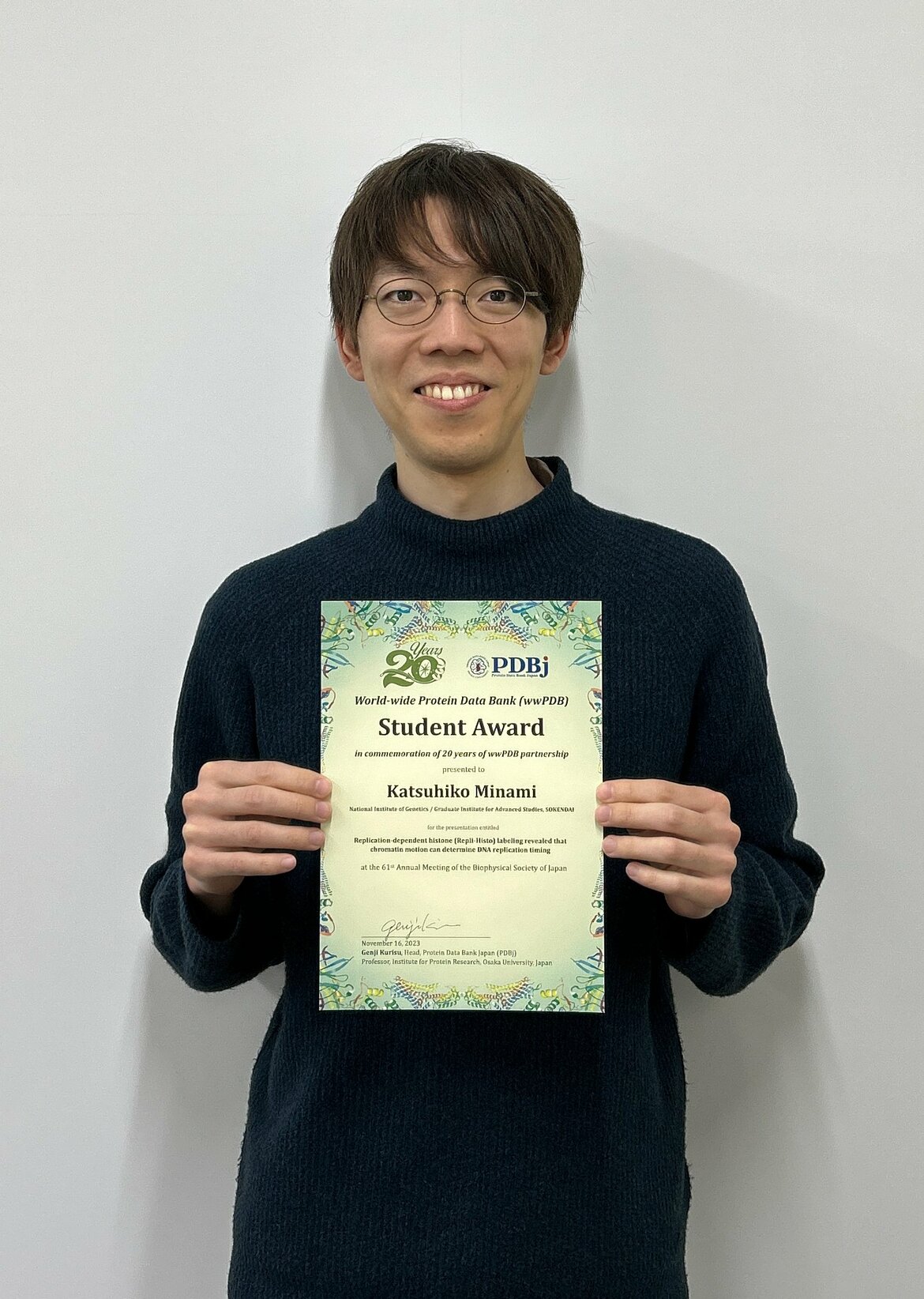 Katsuhiko Minami
Katsuhiko MinamiReplication-dependent histone (Repli-Histo) labeling revealed that chromatin motion can determine DNA replication timing
Katsuhiko Minami (1,2), Satoru Ide (1,2), Sachiko Tamura (1), Masato T. Kanemaki (1,2), Kazuhiro Maeshima (1,2)
1) National Institute of Genetics; 2) Graduate Institute for Advanced Studies, SOKENDAI
Many thanks to the meeting organizers and prize judges for making these awards possible.
The wwPDB Foundation was established in 2010 to raise funds in support of the outreach activities of the wwPDB. The Foundation raised funds to help support PDB50 events, workshops, and educational publications. The Foundation is chartered as a 501(c)(3) entity exclusively for scientific, literary, charitable, and educational purposes.
Consider supporting the next 50 years of PDB's spirit of openness, cooperation, and education with a donation to the wwPDB Foundation.
01/08/2024
Resources for Supporting the Extended PDB ID Format (pdb_00001abc)
wwPDB anticipates that all the four character PDB accession codes (PDB ID) will be consumed by 2029.
With the continuous growth of PDB archive, wwPDB has revised the PDB accession code format by extending its length and prepending “PDB” (e.g., "1abc" will become "pdb_00001abc"). This process will enable text mining detection of PDB entries in the published literature and allow for more informative and transparent delivery of revised data files.
Entries with extended PDB IDs (12 characters) will not be compatible with the legacy PDB file format once four-character PDB IDs are consumed. wwPDB encourages scientific journals, PDB community and users to transition to using the PDBx/mmCIF format and the extended PDB ID format as soon as possible.
Resources are available to help PDB users with this transition through the wwPDB resource portal page (Extended PDB ID With 12 Characters). This page links to useful resources for handling this change, including an FAQ on PDB ID extension, materials to learn more about PDBx/mmCIF format, and links to other PDBx/mmCIF resources and software tools. As the transition phase progresses, more training resources will be added to this page.
Additionally, a PDB “beta” archive will be provided during the transition phase in 2026. The directory structure of this “beta” archive will mirror the data organization of the PDB Versioned Archive in the form of https://files-beta.org/pub/pdb/data/entries/two-letter-hash/pdb_accession_code/entry_data_File_names. The two-letter hash will be based on the n-2 and n-3 characters. For example, PDB entry PDB_12345678 will be under /67/. This will maintain consistency with the current PDB archive, where e.g. PDB entry 1abc is under /ab.
Once all the four character PDB accession codes are consumed, this PDB “beta” archive will become the PDB main archive and the current PDB archive will be removed.
Download example files containing extended PDB IDs for software adoption from GitHub.
wwPDB recently announced that PDB three-character Chemical Component IDs have been consumed. Five-character alphanumeric accession codes for CCD IDs are now issued by the OneDep system.
For any further information please contact us at info@wwpdb.org.
 Sample extended PDB ID
Sample extended PDB ID
01/03/2024
Time-stamped Copies of PDB and EMDB Archives
 New archive snapshots are available.
New archive snapshots are available. A snapshot of the PDB Core archive (ftp://ftp.wwpdb.org, https://s3.rcsb.org) as of January 2, 2024 has been added to ftp://snapshots.wwpdb.org, https://s3snapshots.rcsb.org (AWS), and ftp://snapshots.pdbj.org. Snapshots have been archived annually since 2005 to provide readily identifiable data sets for research on the PDB archive.
The directory 20240101 includes the 214,121 experimentally-determined structure and experimental data available at that time. Atomic coordinate and related metadata are available in PDBx/mmCIF, PDB, and XML file formats. The date and time stamp of each file indicates the last time the file was modified. The snapshot of PDB Core Archive is 1,242 GB.
A snapshot of the EMDB Core archive (ftp://ftp.ebi.ac.uk/pub/databases/emdb/) as of January 01, 2024 can be found in ftp://ftp.ebi.ac.uk/pub/databases/emdb_vault/20240101/ and ftp://snapshots.pdbj.org/20240101/. The snapshot of EMDB Core Archive contains map files and their metadata within XML files for both released and obsoleted entries (32,033 and 282, respectively) and is 14 TB in size.